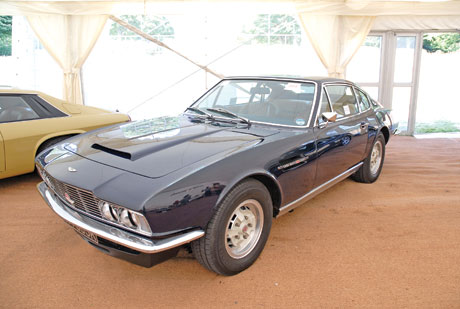No chassis number available
Aston Martin was in trouble again. By the mid-1960s, it was clear that the DB6 was in dire need of modernization, based as it was on a design with its roots firmly in the now-archaic DB4, which was launched in 1958. William Towns, who would serve Aston well (if controversially at times) through the 1970s, was brought in to design a thoroughly modern car.
The resulting DBS was the last of the David Brown Aston Martins, and while looking little like its predecessor, save for the hood scoop, side vents and fastback design, it was nonetheless a pleasing if bland design. When originally released, under the bonnet there was the same 4-liter Tadek Marek-designed, DOHC, straight-6 as in the DB6; later cars got Marek’s 5.3-liter V8. And while some people dump on the first-gen 6-cylinder DBS, they do put out a healthy 325 hp in Vantage form. Figures weren’t released for the V8, but it’s doubtful that in normal tune it put out much more than the Vantage six. For the record, the normal six made 280 hp.
The DBS was the last Aston to offer knockoff wire wheels. Standard were 72-spoke chrome Dunlops with an earless “safety” center nut, with later cars getting the V8-style alloys. A ZF 5-speed was the standard gearbox, with a Chrysler slushbox optional.
Although the bodies of the DBS were aluminum, weight had crept up to nearly two tons, accounting for the more leisurely performance of the six in standard tune. Ride was firm but not punishing, courtesy of a semi-independent DeDion rear located by coil springs. Power steering and four-wheel disc brakes were standard-what one expected of an expensive GT of the time.
The DBS has previously languished along with Ferrari’s 400i, Lamborghini’s Espada, and Maserati’s Indy as bargain exotics, and thus there are many substandard examples out there. Even though values have risen, it’s fiscal suicide to lust after a DBS with significant needs. While the aluminum bodies don’t rust, chassis do, and they suffer from corrosion where steel meets alloy. And while most parts are still available from Aston, they are quite expensive. Plan on spending around $20k on an engine rebuild. Or better yet, plan on steering clear of an example in need of an overhaul.
Interiors, save for the lovely Connolly hides, are somewhat Spartan, as were most Astons prior to the October 1978 “Oscar India” V8s, with no burled walnut to be found anywhere. Luxury features like power windows and a/c were also common. While not as iconic a Bond car as the DB5 (no doubt owing to its appearance in a less than memorable flick), the DBS was famous as the death car for James’s wife Tracy, played by Diana Rigg in “On Her Majesty’s Secret Service.”
Formerly derided as “hopeless” or a perennial SCM D-lister, the DBS has been buoyed by a general increase in affection for all things David Brown and his marque. It has been quite some time since decent cars were available in the teens. The mid-thirties is now the entry level for a DBS, with really nice cars about $10k more. Private sellers have been asking as high as $60k recently. The cars still priced in the twenties are the ones that were $12k cars a few years ago.
Although they’ve more than doubled in the last six or seven years, there’s nothing out of whack about the current market, although one would have to say it’s getting close to fully priced for now. The DBS still represents fair value for the money compared to contemporary Ferraris, which sell for around three times as much.
